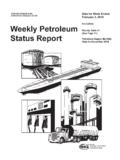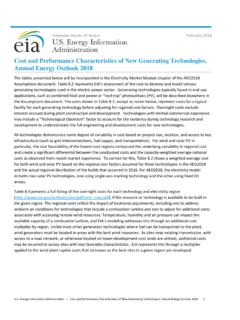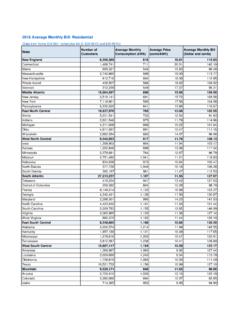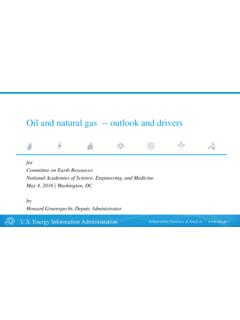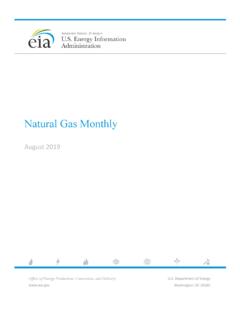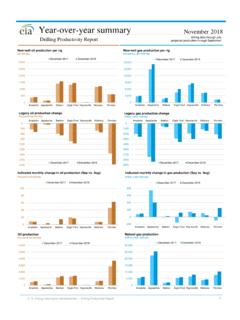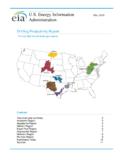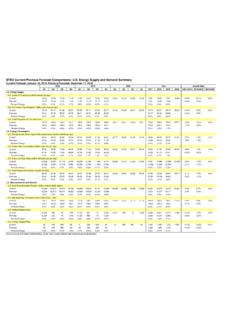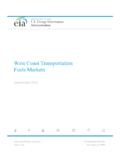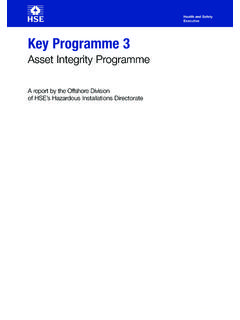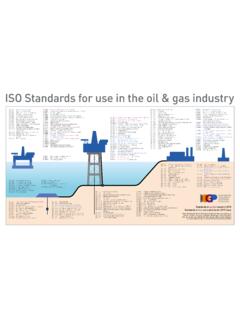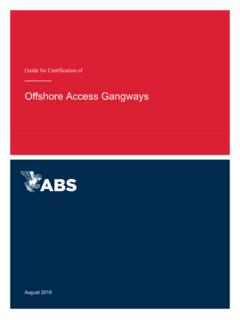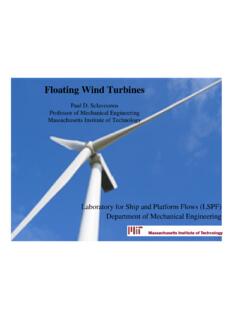Transcription of Oil and Gas Supply Module - Energy Information …
1 March 2022. Oil and Gas Supply Module The National Energy Modeling System's (NEMS) Oil and Gas Supply Module (OGSM) is a comprehensive framework used to analyze crude oil and natural gas exploration and development by region (Figure 1). The OGSM is organized into four submodules: Onshore Lower 48 Oil and Gas Supply Submodule offshore Oil and Gas Supply Submodule Oil Shale Supply Submodule 1. Alaska Oil and Gas Supply Submodule 2. Our publication, Oil and Gas Supply Module of the National Energy Modeling System: Model Documentation 2020, DOE/EIA-M063 (2020) (Washington, DC, 2020), provides a detailed description of the OGSM submodules. The OGSM provides crude oil and natural gas short-term Supply parameters to the Natural Gas Market Module and to the Liquid Fuels Market Module .
2 The OGSM simulates the activity of firms that produce oil and natural gas from fields throughout the United States. Figure 1. Oil and Gas Supply Module regions OGSM encompasses domestic crude oil and natural gas Supply by several recovery techniques and sources. Crude oil Supply includes recovery from highly fractured, continuous zones (for example, Austin Chalk, Bakken, Eagle Ford, and Wolfcamp shale formations) that primarily use horizontal drilling combined with hydraulic fracturing. In addition, crude oil Supply includes improved oil recovery processes such as water flooding and infill drilling, as well as enhanced oil recovery (EOR) processes such as carbon dioxide (CO2) flooding, steam flooding, and polymer flooding. Natural gas Supply includes resources from low-permeability tight sand formations, shale formations, coalbed methane, and other sources.
3 Energy Information Administration | Assumptions to the Annual Energy Outlook 2022: Oil and Gas Supply Module 1. March 2022. Key Assumptions Domestic crude oil and natural gas technically recoverable resources The outlook for domestic crude oil production is highly dependent on the production profile of individual wells over time, the cost of drilling and operating those wells, and the revenues generated by those wells. Every year, we re-estimate initial production (IP) rates and production decline curves, which determine estimated ultimate recovery (EUR) per well and total technically recoverable resources (TRR). 3. A common measure of the long-term viability of domestic crude oil and natural gas as Energy sources is the remaining TRR, which consists of proved reserves 4 and unproved resources.
4 5 Estimates of TRR are highly uncertain, particularly in emerging plays where relatively few wells have been drilled. Early estimates tend to vary and shift significantly over time because new geological Information is gained through additional drilling, long-term productivity is clarified for existing wells, and the productivity of new wells increases with technology improvements and better management practices. The TRR estimates that we use for each Annual Energy Outlook (AEO) are based on the latest available well production data and Information from other federal and state governmental agencies, industries, and academia. Table 1. Technically recoverable crude oil resources as of January 1, 2020. Proved Unproved Total technically reserves, resources, recoverable resources, Region billion barrels billion barrels billion barrels Lower 48 states onshore East Gulf Coast Midcontinent Southwest Rocky Mountain Northern Great Plains West Coast Lower 48 states offshore Gulf (currently available for leasing) Eastern/Central Gulf (unavailable for leasing until 2033) Pacific Atlantic Alaska (onshore and offshore ) Total United States Source: Lower 48 onshore and state offshore Energy Information Administration (EIA); Alaska Geological Survey (USGS); federal (Outer Continental Shelf) offshore Bureau of Ocean Energy Management; proved reserves EIA.
5 Table values reflect removal of intervening reserves additions between the date of the latest available assessment and January 1, 2020. Note: Crude oil resources include lease condensates but do not include natural gas plant liquids or kerogen (oil shale). Resources in areas where drilling is officially prohibited are not included in this table. The estimate of billion barrels of crude oil resources in the Northern Atlantic, Northern and Central Pacific, and within a 50-mile buffer off the Mid- and Southern Atlantic Outer Continental Shelf (OCS) is also excluded from the technically recoverable volumes because leasing is not expected in these areas. Energy Information Administration | Assumptions to the Annual Energy Outlook 2022: Oil and Gas Supply Module 2.
6 March 2022. Table 2. Technically recoverable dry natural gas resources as of January 1, 2020. Proved Unproved Total technically reserves, resources, recoverable resources, trillion cubic feet trillion cubic feet trillion cubic feet Lower 48 states onshore 1, 2, East Gulf Coast Midcontinent Southwest Rocky Mountain Northern Great Plains West Coast Lower 48 states offshore Gulf (currently available) Eastern/Central Gulf (unavailable until 2033) Pacific Atlantic Alaska (onshore and offshore ) Total United States 2, 2, Source: Lower 48 onshore and state offshore Energy Information Administration (EIA); Alaska Geological Survey (USGS); federal (OCS) offshore Bureau of Ocean Energy Management; proved reserves EIA. Table values reflect removal of intervening reserve additions between the date of the latest available assessment and January 1, 2020.
7 Notes: Resources in other areas where drilling is officially prohibited are not included. The estimate of trillion cubic feet of natural gas resources in the Northern Atlantic, Northern and Central Pacific, and within a 50-mile buffer off the Mid- and Southern Atlantic Outer Continental Shelf (OCS) is also excluded from the technically recoverable volumes because leasing is not expected in these areas. The resources presented in the tables in this document are the starting values for the model. Technology improvements in the model add to the unproved TRR, which can be converted to reserves and finally to production. In addition, the TRR is based on an assumed well spacing to calculate the number of remaining drill sites, and the model allows for closer spacing if economical, even with diminishing returns per well as a result of increased well interference.
8 The tables in this document do not include these increases in TRR, so cumulative production from 2020 through 2050 could exceed the presented TRR. The remaining unproved TRR for a continuous-type shale gas or tight oil area is the product of area with potential, well spacing (wells per square mile), and EUR per well. Table 3 and Table 4 summarize the assumptions for unproved technically recoverable resources for tight oil, shale gas, tight gas, and coalbed methane at the play level. The Module uses a distribution of EUR per well in each play and often in sub-play areas. Because of the significant variation in well productivity within an area, the wells in each play are further delineated by county. We provide this level of detail for select plays on our production decline curve analysis page.
9 Energy Information Administration | Assumptions to the Annual Energy Outlook 2022: Oil and Gas Supply Module 3. March 2022. Table 3. unproved technically recoverable tight and shale oil and natural gas resources by play (as of January 1, 2020). Average EUR Technically recoverable resources Area with Average Natural potential1 spacing Crude oil2 Natural gas Crude oil gas NGPL. Region/basin Play (mi2) (wells/mi2) (MMb/well) (Bcf/well) (Bb) (Tcf) (Bb). East Appalachian Bradford-Venango-Elk 16,226 Appalachian Burket-Geneseo 985 Appalachian Clinton-Medina-Tuscarora 18,579 Appalachian Devonian 28,603 Appalachian Huron 5,715 Appalachian Marcellus Foldbelt 867 Appalachian Marcellus Interior 22,939 Appalachian Marcellus Western 2,476 Appalachian Utica-Gas Zone Core 8,766 Appalachian Utica-Gas Zone Extension 14,598 Appalachian Utica-Oil Zone Core 1,355 Appalachian Utica-Oil-Zone Extension 5,641 Black Warrior Chattanooga 1,517 Illinois New Albany 3,013 Michigan Antrim Shale 12,938 Michigan Berea Sand 6,677 Gulf Coast Black Warrior Chattanooga 624 Black Warrior Floyd-Neal 4,315 Texas-Louisiana- 2,663 Mississippi Salt Cotton Valley Texas-Louisiana- 1,183 Mississippi Salt Haynesville-Bossier, LA.
10 Texas-Louisiana- 1,282 Mississippi Salt Haynesville-Bossier, TX. Valley and Ridge Conasuaga 1,111 Western Gulf Austin Chalk-Giddings 2,430 Western Gulf Austin Chalk-Outlying 9,698 Western Gulf Buda 7,819 Western Gulf Eagle Ford-Dry Zone 3,336 Western Gulf Eagle Ford-Oil Zone 6,528 Western Gulf Eagle Ford-Wet Zone 3,347 Western Gulf Olmos 3,711 Western Gulf Pearsall 1,198 Western Gulf Tuscaloosa 7,104 Western Gulf Vicksburg 141 Western Gulf Wilcox Lobo 251 Western Gulf Woodbine 1,153 Midcontinent Anadarko Cana Woodford-Dry Zone 742 Anadarko Cana Woodford-Oil Zone 407 Anadarko Cana Woodford-Wet Zone 1,058 Anadarko Cherokee/Red Fork 1,135 Anadarko Cleveland 2,884 Anadarko Granite Wash/Atoka 5,589 Arkoma Caney 878 Arkoma Fayetteville-Central 1,278 Arkoma Fayetteville-West 736 Arkoma Woodford-Arkoma 384 Cherokee Platform Excello-Mulky 17,847 Southwest Fort Worth Barnett-Core 65 Fort Worth Barnett-North 1,917 Fort Worth Barnett-South 4,908 Fort Worth Davis 464 Energy Information Administration | Assumptions to the Annual Energy Outlook 2022: Oil and Gas Supply Module 4.
